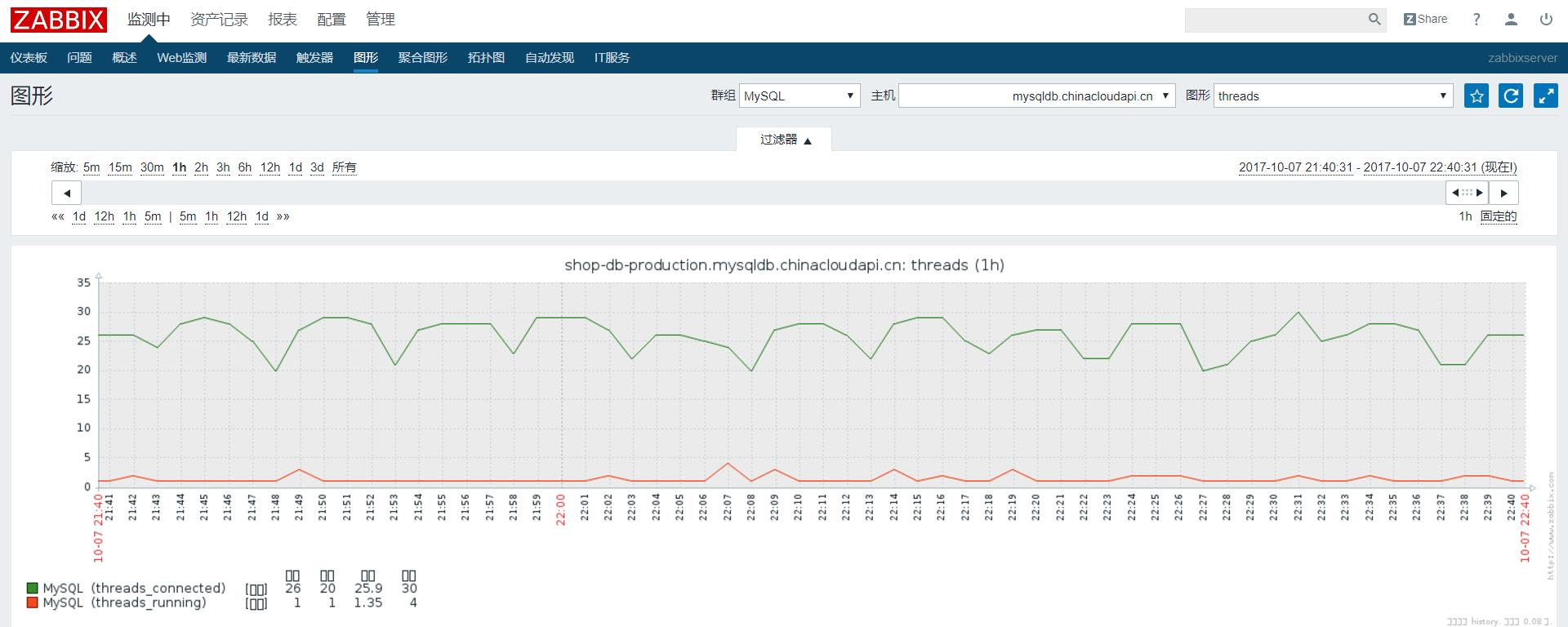Zabbix : 通过修改Zabbix官方redis模板监控微软云Azure上多台MySQL实例
Posted 走心的狗
tags:
篇首语:本文由小常识网(cha138.com)小编为大家整理,主要介绍了Zabbix : 通过修改Zabbix官方redis模板监控微软云Azure上多台MySQL实例相关的知识,希望对你有一定的参考价值。
由于微软云上的mysql实例无法安装插件来导出数据,因此参考上一篇 通过Zabbix官方模板监控微软云Azure上多台Redis实例, 我们可以修改zabbix官方redis脚本,通过show status等命令获取到mysql的状态指标,用trap-messages模式发送给zabbix来监控微软云上的MySQL实例。
1. 运行环境:
OS:CentOS 7.3 / Python: 2.7.3/ Pip: 9.0.1 / Zabbix:3.2.8 / MySQL:微软云MySQL 5.7
Zabbix官方提供的redis监控模板,我们修改官方提供的python脚本来监控MySQL。
项目地址:https://github.com/blacked/zbx_redis_template
Zabbix所有官方模板:http://www.zabbix.org/wiki/Zabbix_Templates
2. 部署
trap-messages方式的说明请参考上一篇 通过Zabbix官方模板监控微软云Azure上多台Redis实例。
1> 安装Python依赖
# yum -y install python-pip # pip install argparse # pip install pymysql
2> 将zbx_redis_stats.py放到zabbix服务器上某路径下并重命名,如/etc/zabbix/script/mysql/zbx_mysql_stats.py。
3> 修改脚本,下面是我修改的脚本,监控了show status获取的信息以及数据库表占用的空间等信息,可以直接拷贝,或者添加自己需要监控的其他信息。

1 # !/usr/bin/python 2 3 import sys, pymysql, json, re, struct, time, socket, argparse 4 5 parser = argparse.ArgumentParser(description=\'Zabbix MySQL status script\') 6 parser.add_argument(\'mysql_hostname\', nargs=\'?\') 7 parser.add_argument(\'metric\', nargs=\'?\') 8 parser.add_argument(\'db\', default=\'none\', nargs=\'?\') 9 parser.add_argument(\'-p\', \'--port\', dest=\'mysql_port\', action=\'store\', help=\'MySQL server port\', default=3306, type=int) 10 parser.add_argument(\'-a\', \'--auth\', dest=\'mysql_pass\', action=\'store\', help=\'MySQL server pass\', default=None) 11 parser.add_argument(\'-u\', \'--user\', dest=\'mysql_user\', action=\'store\', help=\'MySQL server user\', default=None) 12 args = parser.parse_args() 13 14 zabbix_host = \'127.0.0.1\' # Zabbix Server IP 15 zabbix_port = 10051 # Zabbix Server Port 16 17 # Name of monitored server like it shows in zabbix web ui display 18 mysql_hostname = args.mysql_hostname if args.mysql_hostname else socket.gethostname() 19 20 21 class Metric(object): 22 def __init__(self, host, key, value, clock=None): 23 self.host = host 24 self.key = key 25 self.value = value 26 self.clock = clock 27 28 def __repr__(self): 29 result = None 30 if self.clock is None: 31 result = \'Metric(%r, %r, %r)\' % (self.host, self.key, self.value) 32 else: 33 result = \'Metric(%r, %r, %r, %r)\' % (self.host, self.key, self.value, self.clock) 34 return result 35 36 37 def value_format(value): 38 if value.isdigit() is True: 39 value = int(value) 40 return value 41 42 43 def send_to_zabbix(metrics, zabbix_host=\'127.0.0.1\', zabbix_port=10051): 44 result = None 45 j = json.dumps 46 metrics_data = [] 47 for m in metrics: 48 clock = m.clock or (\'%d\' % time.time()) 49 metrics_data.append( 50 (\'{"host":%s,"key":%s,"value":%s,"clock":%s}\') % (j(m.host), j(m.key), j(m.value), j(clock))) 51 json_data = (\'{"request":"sender data","data":[%s]}\') % (\',\'.join(metrics_data)) 52 data_len = struct.pack(\'<Q\', len(json_data)) 53 packet = \'ZBXD\\x01\' + data_len + json_data 54 55 # For debug: 56 # print(packet) 57 # print(\':\'.join(x.encode(\'hex\') for x in packet)) 58 59 try: 60 zabbix = socket.socket() 61 zabbix.connect((zabbix_host, zabbix_port)) 62 zabbix.sendall(packet) 63 resp_hdr = _recv_all(zabbix, 13) 64 if not resp_hdr.startswith(\'ZBXD\\x01\') or len(resp_hdr) != 13: 65 print(\'Wrong zabbix response\') 66 result = False 67 else: 68 resp_body_len = struct.unpack(\'<Q\', resp_hdr[5:])[0] 69 resp_body = zabbix.recv(resp_body_len) 70 zabbix.close() 71 72 resp = json.loads(resp_body) 73 # For debug 74 # print(resp) 75 if resp.get(\'response\') == \'success\': 76 result = True 77 else: 78 print(\'Got error from Zabbix: %s\' % resp) 79 result = False 80 except: 81 print(\'Error while sending data to Zabbix\') 82 result = False 83 finally: 84 return result 85 86 87 def _recv_all(sock, count): 88 buf = \'\' 89 while len(buf) < count: 90 chunk = sock.recv(count - len(buf)) 91 if not chunk: 92 return buf 93 buf += chunk 94 return buf 95 96 97 def main(): 98 if mysql_hostname and args.metric: 99 100 client = pymysql.connect(host=mysql_hostname, user=args.mysql_user, password=args.mysql_pass) 101 cursor = client.cursor() 102 cursor.execute("show status") 103 data = cursor.fetchall() 104 dict_local = {} 105 for k, v in data: 106 dict_local[k] = v 107 108 cursor.execute("select SCHEMA_NAME from information_schema.schemata ") 109 db = cursor.fetchall() 110 dblist = [] 111 for i in db: 112 dblist.append(i[0]) 113 114 if args.metric: 115 def list_db(): 116 if args.db in dblist: 117 print(dblist) 118 else: 119 print(\'database_detect\') 120 121 def default(): 122 if args.metric in dict_local.keys(): 123 print(dict_local[args.metric]) 124 125 { 126 \'list_db\': list_db 127 }.get(args.metric, default)() 128 129 else: 130 print(\'Not selected metric\') 131 else: 132 client = pymysql.connect(host=mysql_hostname, user=args.mysql_user, password=args.mysql_pass) 133 cursor = client.cursor() 134 cursor.execute("show status") 135 data = cursor.fetchall() 136 137 a = [] 138 for k, v in data: 139 k = k.lower() 140 v = value_format(v) 141 a.append(Metric(mysql_hostname, (\'azuremysql[%s]\' % k), v)) 142 143 # cursor.execute("show processlist;") 144 cursor.execute("select count(*) from information_schema.processlist;") 145 processdata = cursor.fetchall() 146 # process_count = len(processdata) 147 process_count = processdata[0][0] 148 a.append(Metric(mysql_hostname, \'azuremysql[process_count]\', process_count)) 149 150 cursor.execute( 151 "select table_schema,round(sum(data_length+index_length)/1024/1024,4) from information_schema.tables group by table_schema;") 152 spacedata = cursor.fetchall() 153 totalspace = 0 154 for k, v in spacedata: 155 a.append(Metric(mysql_hostname, (\'azuremysql[%s]\' % k), float(v))) 156 totalspace += float(v) 157 a.append(Metric(mysql_hostname, \'azuremysql[totalspace]\', totalspace)) 158 159 # Send packet to zabbix 160 send_to_zabbix(a, zabbix_host, zabbix_port) 161 # for i in a: 162 # print(i) 163 cursor.close() 164 client.close() 165 166 167 if __name__ == \'__main__\': 168 main()
4> 测试脚本是否可以正常连接到微软云上MySQL并获取参数:
/etc/zabbix/script/mysql/zbx_mysql_status.py -u mysqluser -a mysqlpasswd test.mysqldb.chinacloudapi.cn list_db
5> 添加crontab,定期执行脚本发送数据给zabbix,注意若密码中含有%需要用 \\ 进行转义 (\\%)。
若要监控多台MySQL,则添加多个crontab:
*/1 * * * * /etc/zabbix/script/mysql/zbx_mysql_status.py -u mysqluser -a mysqlpasswd test.mysqldb.chinacloudapi.cn
6> 创建MySQL监控模板,注意监控项类型应选择"zabbix采集器",若使用的脚本,键值为"azuremysql[xxxxxxx]",否则请使用自己脚本定义的键值。
附件是我创建的一个模板,添加了一些监控项,并不完整,可以在此基础上再添加需要的监控项。
7> 使用MySQL hostname创建主机,链接模板,即可实现zabbix监控。

以上是关于Zabbix : 通过修改Zabbix官方redis模板监控微软云Azure上多台MySQL实例的主要内容,如果未能解决你的问题,请参考以下文章
